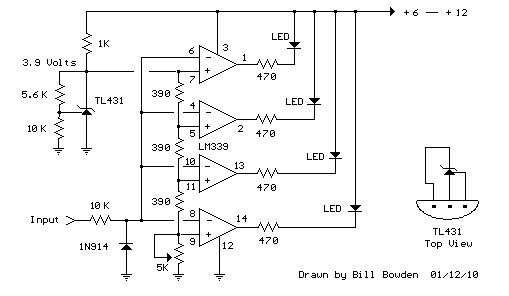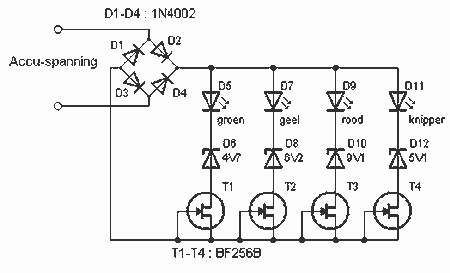
Battery Tester/Indicator/Monitor

This is a battery tester circuit. This circuit is used to indicate whether the level of a battery voltage is normal, under-voltage, or over-voltage.
The battery tester circuit is designed to assess the voltage level of a battery and provide a visual indication of its status. It typically employs a voltage divider network to scale down the battery voltage to a measurable level suitable for comparison with reference voltages. The circuit often incorporates a comparator, such as an operational amplifier, which compares the scaled voltage against predefined thresholds representing normal, under-voltage, and over-voltage conditions.
When the battery voltage is within the normal range, the output of the comparator is activated, lighting an LED or activating a display to indicate that the battery is functioning correctly. If the voltage falls below the normal range, the comparator triggers a different LED or alert mechanism, indicating under-voltage, which suggests that the battery may require recharging or replacement. Conversely, if the voltage exceeds the upper threshold, another indicator will signal that the battery is over-voltage, which could indicate potential damage or malfunction.
Additional components may include resistors for setting the reference voltage levels, capacitors for filtering any noise in the signal, and possibly a microcontroller for more advanced features such as data logging or communication with other devices. The circuit can be powered by the battery being tested or an external power source, ensuring versatility in various applications. This battery tester circuit is essential for maintaining the health of battery-operated devices and ensuring optimal performance.This is a battery tester circuit.This circuit is used to indicate whether the level of a battery voltage is normal, under-voltage, or over-voltage, very.. 🔗 External reference
The battery tester circuit is designed to assess the voltage level of a battery and provide a visual indication of its status. It typically employs a voltage divider network to scale down the battery voltage to a measurable level suitable for comparison with reference voltages. The circuit often incorporates a comparator, such as an operational amplifier, which compares the scaled voltage against predefined thresholds representing normal, under-voltage, and over-voltage conditions.
When the battery voltage is within the normal range, the output of the comparator is activated, lighting an LED or activating a display to indicate that the battery is functioning correctly. If the voltage falls below the normal range, the comparator triggers a different LED or alert mechanism, indicating under-voltage, which suggests that the battery may require recharging or replacement. Conversely, if the voltage exceeds the upper threshold, another indicator will signal that the battery is over-voltage, which could indicate potential damage or malfunction.
Additional components may include resistors for setting the reference voltage levels, capacitors for filtering any noise in the signal, and possibly a microcontroller for more advanced features such as data logging or communication with other devices. The circuit can be powered by the battery being tested or an external power source, ensuring versatility in various applications. This battery tester circuit is essential for maintaining the health of battery-operated devices and ensuring optimal performance.This is a battery tester circuit.This circuit is used to indicate whether the level of a battery voltage is normal, under-voltage, or over-voltage, very.. 🔗 External reference





